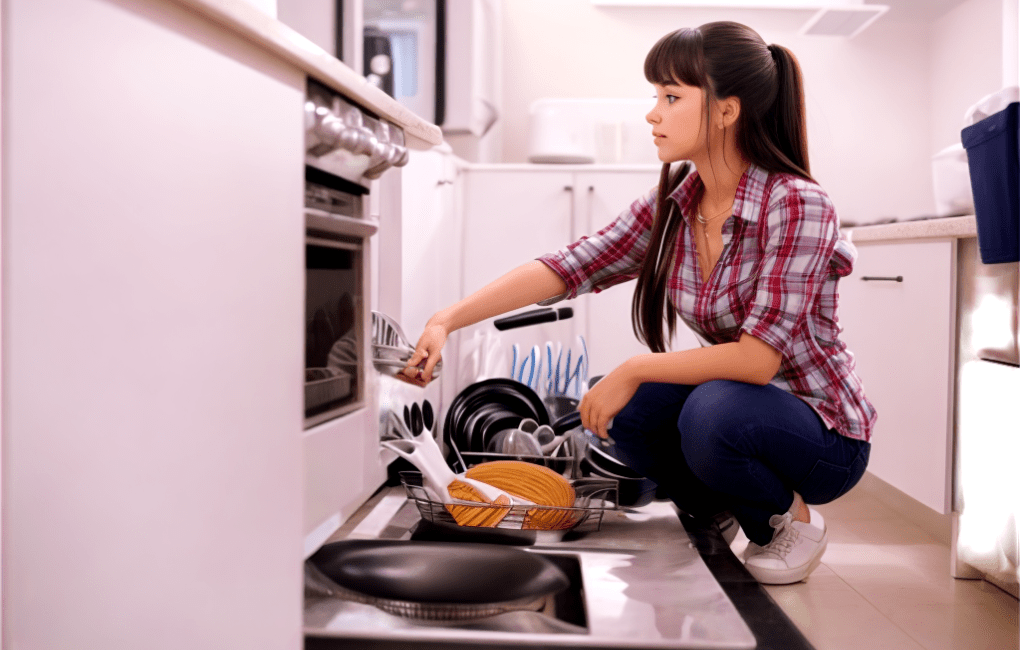Compact dishwashing machines are very helpful in the kitchen because modern life is very fast-paced, and every second is very important too. Up until now, a small, powerful dishwashing machine has been perfect if you want to save space and be an expert. This guide explains how portable dishwashers work. The portable dishwasher has different parts. Water moves inside. It heats up. People use detergent. It is loaded. It is kept purify. Every busy kitchen enjoys it and improves comfortably. Are you ready to take a trip inside the minds of these cooking helpers? Let’s jump right in!
Explanation of Dishwasher Components: The Basics
There are many different parts in every moving dishwashing machine that all work together to make it work. The several important parts of a portable dishwasher are: the pump and motor, heating element, spray arms, detergent dispenser, water intake, drainage systems, and connection to the kitchen tap.
Pump and motor: The pump and motor are a powerful pair that move water through the dishwasher’s complicated system. The pump works when the engine hums, forming the cleaning process.
Heating element: The heating element is an important part of the dishwasher because it ensures the water is at the perfect temperature. This not only makes the soap work better, but it is also essential for drying.
Spray arms: Think of them as the people who make cleaning look good. This machine has moving arms that spread water, so your dishes get the necessary care.
Detergent dispenser: The detergent dispenser is the first step in cleaning. Knowing how to load it and what it does is essential for getting perfect results every time.
Water inlet and drainage systems
This part is the yin and yang of dishwasher functionality. The water enters through the intake, dances through the cleaning process, and flows through the drainage system.
Connection to the kitchen faucet: Ease of use and new ideas meet. A simple link that turns your kitchen tap into a washing water source, so you don’t have to deal with complicated plumbing.
Role of the drain hose : The overlooked hero who ensures water drains smoothly, stops puddles, and makes dishwashing go more smoothly.
Power sources
- Electric vs. countertop models: Electric or kitchen island? Knowing the differences between power sources can help you pick a dishwasher that works well with how your kitchen works.
- Energy-efficient features: These dishwashers are handy and good for the environment because they use minimum energy. It is essential in this day and age when sustainability is essential.
The Water Circulation Process: The way Portable Dishwashers Work
Inlet of water
The dishwasher skillfully connects to the kitchen tap before setting out on its voyage. It isn’t simply a link; it’s a handshake that changes everything, transforming a regular fixture into a dynamic water source for the impending aquatic show. Think of this aquatic symphony’s conductor as the water temperature factor. The right water temperature coordinates the dissolution of detergents and the removal of dirt from your plates, much like a maestro conducts an orchestra.
Pump and motor operation
Let’s now focus on the dynamic pair, the motor and pump. The Operation of circulating water through the network is like a choreographed ballet, like a heartbeat. Their contribution to the flow of water goes beyond simple Operation. It’s a team effort, guaranteeing a throbbing flow that makes its way through the complex routes and offers a complete cleaning cascade.
Spray arm functionality
The actual magic happens in the Spray Arm Functionality. Consider these arms as water conductors, coordinating the water’s distribution for effective cleaning. It’s a calculated performance, aiming for every nook and cranny to ensure perfection. Examine the Rotational patterns in greater detail for coverage. Consider it a planned dance that guarantees thorough cleaning coverage. A complex process supervises every plate, ensuring each turn leads to spotless dishes.
Heating and Drying Mechanisms
Importance of heating elements
Heating Elements are unsung stars in the complicated world of dishwashing because they do more than keep dishes warm.
- Built-in heaters and fans: Think of this as a warm breath. Built-in heaters and fans work together to ensure your dishes are clean and perfectly dry, ready for their next culinary journey.
- Condensation drying: This is where the art of condensation drying comes in. The slow dance of water droplets turning into vapor cleans your dishes without using too much heat.
- Air drying vs. heated drying: It’s an old problem. Air drying uses a gentle touch, while heated drying makes the process quick and warm. What to do? A personal choice in the orchestra of cleaning.
Detergent and Rinse Aid Usage
Detergent dispenser function
The Detergent Dispenser is the show’s star when it comes to cleaning dishes; it leads a performance beyond just being clean.
- Loading the detergent : Being careful with this is an art, not a simple job. To achieve a perfect clean, you must carefully and precisely load the detergent.
- Types of dishwasher detergents: There are different kinds of cleaners. Explore the world of different formulas and find the Types of Dishwasher Detergents that best meet your cleaning needs.
- Importance of rinse aid: It turns out that Rinse Aid is the unsung star. Find out what it does to stop water spots and ensure the finish is perfect, finishing the cleaning masterpiece.
Loading and Arranging Utensils
Efficient loading strategies
When it comes to dishwashing, learning efficient loading strategies turns a tedious job into a planned art form and helps portable dishwashers work effectively.
- Rack organization tips: Think of the racks in the dishwasher as your painting. Rack Organisation Tips will help you arrange your dishes with a manager’s care, ensuring that the water flows perfectly for a perfect performance.
- Proper placement of dishes and cookware: You need to know where; you also need to know how. Learn the secrets of Proper Placement to ensure that every plate and pot goes where it’s supposed to go, which will help you clean more thoroughly and quickly.
Maximizing dishwasher capacity
When you have limited room, knowing how to maximize dishwasher capacity is very important because it allows you to get the most out of your space without sacrificing efficiency.
- Utilizing adjustable racks and tines: The key is adaptability. Discover the world of adjustable shelves and tines, which will turn your dishwasher into a place that can fit dishes of all sizes and shapes.
- Loading utensils for optimum cleaning: Loading utensils, from knives to spatulas, turns into art. Please find out the tricks that ensure every tool does its part in the routine, guaranteeing the best cleaning results.
Final Thoughts
Being efficient, flexible, and environmentally friendly means taking advantage of the ease of movable dishwashers in a world where time is valuable. This guide will teach you everything you need to know to get the most out of your portable dishwasher, from understanding its complex parts to learning how to load it and do regular maintenance. The cleaning symphony can now begin! May your dishes always shine with the easy charm of modern ease!
Frequently Asked Questions
How Do Portable Dishwashers Hook Up?
A portable dishwasher hooks up to your sink by attaching an inlet hose to the faucet. It draws water from the sink, heats it, and washes your dishes. When draining, it uses another hose to discharge the dirty water into the sink.
How Do Portable Dishwashers Work while draining?
A portable dishwasher drains by using hoses to supply hot water from the kitchen faucet and another hose to discharge dirty water down the kitchen sink. The faucet connects to both houses. Portable dishwashers are efficient and convenient for washing dishes without a permanent setup.
Are Portable Dishwashers as Good as Built-in Dishwashers?
Portable dishwashers are just as good as built-in dishwashers. They work like standard dishwashers but are on wheels, making them easy to move around. You don’t need a permanent setup; you can connect it to the sink faucet.
Do You Turn on Hot or Cold Water for the Portable Dishwasher?
For a portable dishwasher, you need to turn on the hot water. It uses a hose to supply hot water from the kitchen faucet and another to drain dirty water into the kitchen sink. The faucet connects to both houses



